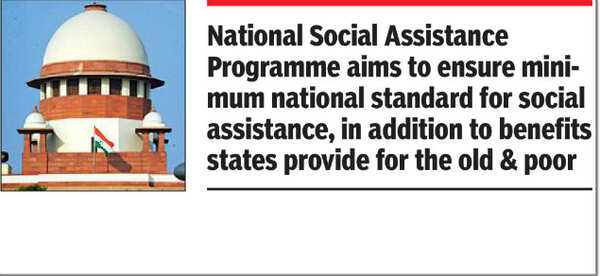By Dr. Gyan Pathak
Despite the Union Government’s claim that social security coverage has been doubled under PM Narendra Modi government within three years from 24.4 per cent in 2021 to 48 per cent in 2024, there has been steep realtime decline in assistance under National Social Assistance Programme (NSAP) since 2014-15 which aims to provide social security and welfare to old age, disabled, and widowed individuals.
The budgetary allocation under the NSAP, has not only stagnated since 2015-16, but also as a percentage of the total Union Budget, its share has fallen sharply from 0.58 per cent in 2014-15 to just 0.19 per cent in the current budget for the year 2025-25. On the other hand, the number of people needing such pensions has increased from the Central cap at 3.09 crore to 5.86 crore during the last decade.
The Ninth report on the ‘Impact of National Social Assistance Programme (NSAP) on the poor and destitute in the villages’ of the Standing Committee on Rural Development and Panchayati Raj presented to the Lok Sabha has noted with concern that the budgetary allocation made for payment of pension under the NSAP have remained stagnant at approximately Rs9,500 crore per annum since 2015–16, with only a marginal increase to Rs 9,652 crore in the Budget Estimates for 2025–26.
This stagnation in allocation, despite inflation and rising beneficiary needs, has resulted in a real-term decline in assistance—wherein the value of the 2025–26 allocation, when adjusted for inflation, is estimated to be only ₹9,200crore. In this way, in real term, there is a decline in even the budgetary allocation which was Rs9500 long back in 2015-16.
The report of the Standing Committee has also pointed out that as a percentage of the total Union Budget, the NSAP’s share has fallen sharply from 0.58% in 2014–15 to just 0.19% in 2025–26.
Though the Modi government has showing itself championing the cause of social security and welfare to the needy it has frozen the number of beneficiaries, though the number of old, disabled, widows and destitutes have been rising. The burden of the rising needy population is being borne by the state governments. It is an irony that Modi government praises itself and criticizes the state government.
The Parliamentary Standing Committee has said, “While the Centre continues to cap its support at 3.09 crore beneficiaries, state governments have taken on a disproportionate burden by covering nearly twice this number which is approximately about 5.86 crore additional beneficiaries.”
The Committee therefore recommended the Department of Rural Development to prepare and submit a revised proposal for Cabinet consideration and approval seeking a substantial enhancement in pension amounts and overall allocations under NSAP.
The Committee noted that several States supplement the central pension provided under the NSAP with additional top-up contributions, which vary significantly from as low as Rs50to as high as ₹3,716 per month per beneficiary.
The Committee are of the view that the absence of a uniform framework for state contributions risks distorting the core objectives of NSAP, which is intended to serve as a minimum national guarantee of social security. The Committee recommended that the Ministry should establish clearly defined minimum and maximum permissible limits for top-up contributions, below and above which states should not be permitted to contribute.
The Committee recommended the Ministry of Rural Development to take concerted efforts to establish a single consolidated list of beneficiaries, determined through a uniform set of eligibility criteria based on recent and verifiable socio-economic data—such as the SECC2011 or some other welfare databases so as to ensure that assistance reaches to those who are genuinely in need, while avoiding arbitrary ceilings and outdated classifications. The creation of a single list, guided by a common national standard, would enhance transparency, reduce administrative burden, and bring coherence between Central and State interventions under NSAP.
The Committee recommended the Ministry of Rural Development to review and simplify the procedural guidelines for enrolment under NSAP, and consider relaxing certain documentation or verification requirements to improve accessibility, especially for beneficiaries belonging to vulnerable and marginalized groups.
For the North-East region, the Committee recommended the Ministry to intensify engagement with these states, conduct special review meetings, and provide targeted technical assistance to expedite onboarding and ensure the effective utilisation of funds without any further delay.
The Committee also recommended that greater emphasis should be placed on developing last-mile delivery systems particularly in geographically isolated and underserved areas to ensure that the process of receiving pension is dignified, accessible, and responsive to the limitations faced by the most vulnerable sections of society. (IPA Service)




